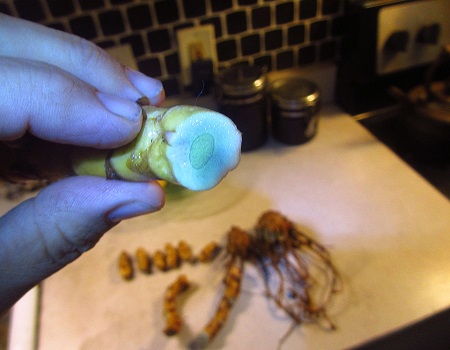Black turmeric
It took me a long time to get my hands on one of these. This is one of the rarest gingers in the USA. The inside of the rhizomes is not really black, but a dark blue. This Indian ginger is used mostly as a medicinal plant. It is reportedly effective for many different ailments, but I am not aware of whether or not such claims have been substantiated.
Magical Properties
Because the rhizome is the same color as the skin of several Hindu deities (Kali, Rama, Krishna, and Shva), it is believed that black turmeric has magical powers. Some Indian people believe that black turmeric rhizomes are a physical embodiment of the goddess Kali and carry rhizomes around with them. The rhizomes are frequently used as a talisman for the purposes of repelling evil spirits. Hindus sometimes mark their forehead with paste made from the rhizomes, believing that it removes curses. I make no claims about the presence or lack of magical properties, but it is fun to imagine having magical plants, like something from a Harry Potter movie.
Origin
India
Family
Zingiberaceae
Binomial nomenclature
Curcuma caesia
Common names
Black turmeric
Description
Curuma caesia is perennial rhizomatous plant, with dark blue rhizomes. The leaves are dark green with a red stripe down the midrib of the blade. Flowering bracts are red. The plant is very similar in size and appearance to zeodary (Curcuma zeodaria).
Height
2′-3′ tall.
Temperature/Zone
zone 9b, 32°F. Curcuma caesia goes through an obligate dormancy like other members of the genus Curcuma, so this is another plant that is a good choice for people in colder climates. It will need to be Wintered indoors, in a paper bag with sawdust or dry potting soil.
Light
Part sun to shade.
Water
Keep them evenly hydrated while they are growing, but keep them dry while they are dormant.
Fertilizer
They should be fed a well balanced fertilizer. It is important to supply them with adequate phosphorus in order for them to grow thick healthy rhizomes and storage roots.
Cultivation
Care for black turmeric is essentially identical to that of regular turmeric (Curcuma longa). They prefer soil that is rich in organic matter.
Pests
I have not found any pests to be a problem for this plant in Florida.
wikipedia


I need to buy this plant
Where can I buy it?
I have some now that I’d part with. email me at randystropicalplants@gmail.com if you are still interested.